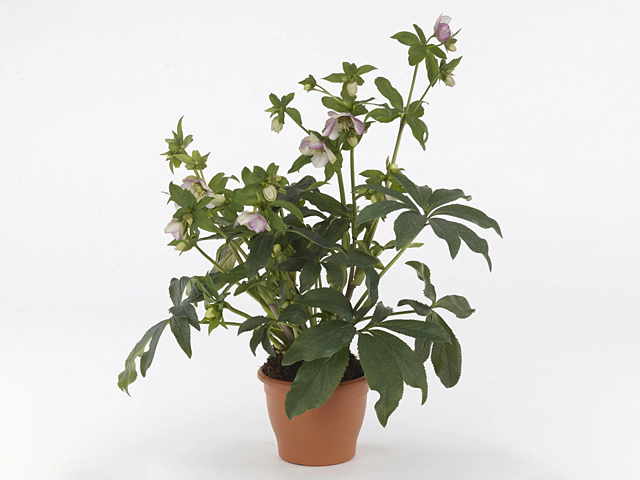Helleborus orientalis Beaming Blush

| Flower type | Single |
| Leaf margin | Serrate |
| Winter hardness | Good (USDA-zone 5, 6) |
| Flower color | Purple-light violet-076C |
| Plant height | 30 - 40 cm |
| Leaf size | 10 - 15 cm |
| soil pH requirement | Alkaline (pH > 7,5); Slightly acidic (pH 4,5 - 6,5); Neutral (pH 6,5 - 7,5) |
| Light conditions | Semi-shades |
| Leaf division | Diversely compound |
| Leaf, main color | Dark green |
| Leaf colour, pattern | Unicolored |
| Flower color distribution | With trace; Multi-colored |
| Flower, secondary color(s) | Purple-light blue pink-069D; White |
| Toxicity (if consumed) | Toxic |
| Moisture requirements | Well-drained; Moist |
| Soil type | Humus rich |
The Helleborus orientalis Beaming Blush, commonly known as the Hellebore, is a beautiful flowering plant that is sure to add a touch of elegance to any garden. With its single flower type and serrate leaf margins, this plant is a standout in any landscape.
One of the great things about the Hellebore is its winter hardness. It can withstand cold temperatures and is suitable for USDA Zones 5 and 6. This makes it a perfect choice for gardeners in regions with harsh winters.
The flower of the Helleborus orientalis Beaming Blush is a stunning shade of purple-light violet, precisely designated as 076C on the color chart. Its unique color adds intrigue and drama to any garden. The plant reaches a height of 30-40 cm, making it a suitable option for borders and front yard planting.
The leaves of this Hellebore are equally captivating. They measure between 10-15 cm in size and have a dark green color, providing a pleasant contrast against the vibrant flowers. The leaves are also diversely compound, adding an interesting texture to the plant.
In terms of soil preferences, the Hellebore is quite versatile. It can thrive in alkaline soil with a pH greater than 7.5, as well as slightly acidic soil with a pH between 4.5 and 6.5. It is also suited for neutral soil with a pH between 6.5 and 7.5. This adaptability allows gardeners to grow the Hellebore in various types of soil.
When it comes to light conditions, the Hellebore prefers semi-shade. It thrives in areas with filtered sunlight or in places that receive partial shade throughout the day. This makes it an excellent plant for gardens with trees or structures that provide some shade.
In terms of appearance, the Hellebore is a sight to behold. Its unicolored dark green leaves are visually appealing, while the flowers boast a multi-colored distribution with a trace of purple-light blue pink and white. The combination of hues creates a stunning display that is sure to catch the eye.
It is worth noting that the Hellebore is toxic if consumed, so caution should be exercised when planting it in areas frequented by children or pets. However, this toxicity does not diminish the plant's aesthetic appeal, and it remains a popular choice among garden enthusiasts.
In terms of care, the Hellebore prefers well-drained, moist soil. It thrives in humus-rich soil that retains moisture without becoming waterlogged. Regular watering is essential for maintaining its health and vibrant appearance.
In conclusion, the Helleborus orientalis Beaming Blush is a remarkable plant that offers a range of attractive features. From its striking flowers to its diversely compound leaves, this plant is a true gem in any garden. With its adaptability to various soil types and light conditions, as well as its winter hardiness, it is a practical choice for avid gardeners. Just remember to keep it away from curious children and animals due to its toxicity.
Market availability index by month:
| Jan. | Feb. | Mar. | Apr. | May | Jun. | Jul. | Aug. | Sep. | Oct. | Nov. | Dec. |
|---|---|---|---|---|---|---|---|---|---|---|---|
| 3 | 3 | 2 | 1 | - | - | - | 1 | 2 | 3 | 4 | 2 |